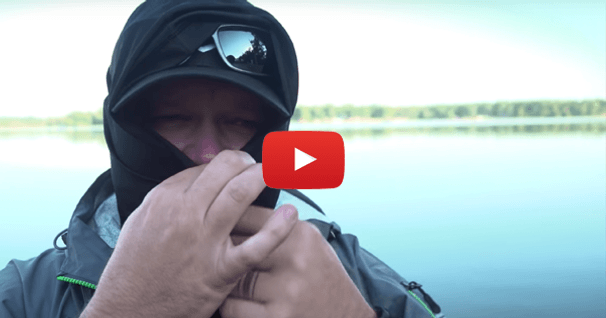Types of Campfires
I have to believe that one of the first things a critter did once it climbed out of the primordial ooze was to seek warmth. I can certainly relate to that quest at the end of a long paddling day. Despite the fact that proper clothing should provide its wearer with adequate warmth, there is still something about the glow and radiant heat of a good campfire that all the right garments can never provide.
Like a friendly mongrel mutt, any fire can give you feelings of warmth. However, knowing how different fires direct and produce differing amounts of heat can help you make the best fire for different circumstances. The "science" of a fire is based on three elements: fuel, oxygen and heat. The fuel is the material that will start and then keep the fire burning. In order to burn it must have oxygen. The oxygen combines with the gases emitted from the fuel as its consumed - that gas is released by heat applied to the fuel. Eventually the fuel is consumed, the energy is released in light and heat and the process is sustained by adding more fuel or reinitiated when a fire is needed again.
The key to any good fire is a quick start, sometimes with only one or two chances to do so. Good tinder - small dry shavings or strands or globs or drippings of quickly combustible material used to start a fire - is critical. Practice with what ever fire igniter you prefer and practice lighting the myriad varieties of tinder you can find outdoors: cattail fluff, birch bark, shredded dry leaves, small blades and stalks of grass, lint from you pockets - practicing what lights quickly and produces enough heat to start your tinder burning is a key skill in becoming a competent fire starter. Tinder is the base of your fire. Most any larger fire will usually be started from a tiny, burning pile of tinder (unless you happen to go the shortcut route and use Boy Scout Juice - lantern fuel!)
50 years of lightweight, maneuverable, high-performing kayaks.
Check out this interview with Tom Keane, Eddyline Kayaks Co-Owner, on their journey!
Once you're comfortable selecting and using tinder, learn what type of kindling can be used to further fuel your fire. The tinder should burn long and hot enough to generate the gases that will ultimately ignite and start the combustion process with the larger pieces of wood or burning material that will be used to sustain your fire for a longer period of time.
Tinder is usually dry sticks and twigs that can usually be collected on the ground, or in wet country, from downed and dead branches and trees. It's often called "squaw wood" inferring it can be gathered without tools and much effort. Sometimes larger, thicker pieces of bark or even stout canes and stalks from vegetation can be used as kindling. Tinder can also be used to generate a quick burst of heat for cooking, or light for better visibility around the camp. Once a fire is up and going, the larger pieces of wood can be used to maintain the fire with less monitoring than with smaller, more quickly consumed materials. All fires are not the same; they can be built for specific purposes, to accent either heat or light, and can be constructed so as to radiate heat in a certain direction.
TEEPEE FIRE:
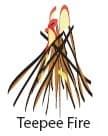
This is probably the most basic of fire designs. It is often used as a starter upon which bigger, longer-lasting fires are founded. It's also a great fire for a quick warm-up or water-boiling snack break. This fire uses mostly kindling, but larger teepees can be created by adding larger logs vertically to the fire. Many beach fires are large teepee fires where pole-sized driftwood is laid upright against others to form this familiar shape. A teepee fire is a good fire to direct heat upward and can be used beneath a hung pot on a tripod for fast heating.
PYRAMID/PLATFORM FIRE:
This fire consists of a foundation framework of large logs laid side by side to form a solid base. A slightly shorter log is laid perpendicular and on top of this first layer. Each subsequent layer is slightly shorter as the platform or pyramid rises. This solid mass of right angle firewood takes a little effort to light but it's well worth it for the huge amount of coals it produces, especially when the fire is lit on the top most layer and burns down through the layers.
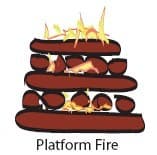
A lighter version of the Pyramid fire is the platform. It's similar in shape to the pyramid fire except the logs are layered only along the outside edge (like walls on a log cabin) with each level of logs slightly shorter than the ones beneath. This creartes a hollow wood platform into which smaller kindling can be placed and ignited. It can provide quick warmth and be the start of any number of larger blazes.
PARALLEL FIRE:

Sometimes a fire is build between two long logs. If the logs are the same size, the tops of the log can be used to place pots for cooking.. It has the added advantage of prolonging the fire since the insides of the log are burning too, and its easy to direct the fire up or down the length of the side log, literally until the entire log eventually consumed. A similar fire is the trench fire, used almost exclusively for cooking. These work by either blocking the wind or in funneling the wind into the fire for a more concentrated and hotter "burn". Several pots can be placed over the trench and the fire can be maintained at different levels for a variety of cooking options.
STAR or INDIAN FIRE:
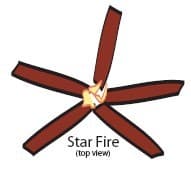
A star fire, or Indian fire, is the fire design often depicted as the campfire of the old West. Imagine five or six logs laid out like the spokes of a wheel (star shaped). A fire is started at the "hub" and each log is pushed towards the center as the ends are consumed. It's another fire that can be kept burning all night long with little maintenance.
REFLECTOR FIRE:
A reflector fire is really any fire that has some sort of flat surface behind it to direct the heat back out past the fire. This surface is erected behind the fire and pointed, for example, at the face of a tent, lean-to or other shelter. This back reflector can be made out of a few large slabs of bark, several logs laid against supports and stacked upon each other to form the surface. Rocks can also be used but just like those used to ring a fire, make sure they do not contain moisture. That trapped moisture can be heated to where it's like a steam engine with no release valve. Exploding rocks can send shrapnel and shards flying in every direction!
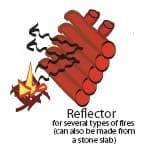
Several fire starters are on the market, from the basic match to clever kits that contain a flint-like material and striker unit all packaged together. Space-age lighters and water/stormproof matches all can be your choice of fire starter. The most important thing to remember about fires is learning how to build and lit them long before you need one to save your life. Practice at home, make it a ceremonial task at your next camp out.
As humans I am convinced that the feelings evoked by a good campfire are remnants of our cave-dwelling ancestral days. Even if we have a good coat on our back, and a belly full of warm food cooked on a camp stove, there is something about a fire that makes the campsite complete.
Tom Watson, an avid sea kayaker and freelance writer is also the author of "How to Think Like A Survivor" currently available on Amazon.com and most major bookstores.
Related Articles
This a follow up to a video I did where I talked about differences that you may find in dry and semi-dry…
Can you use a Greenland Paddle in a Recreational Kayak? I received this question recently from a…
Learn how to stay comfortable on the water when fishing in the cold. When you stay warm and…
I just couldn't resist having just one more trip before the season ended and the lakes froze. So, on the…



